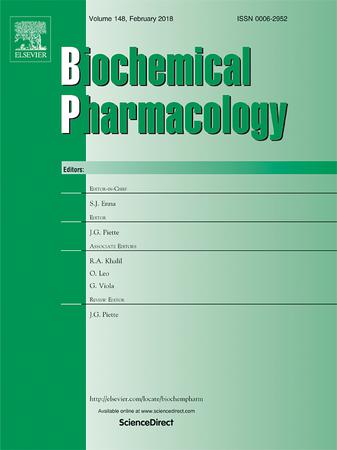Dimethylmalonate induces ferroptosis by inhibiting the SUCNR1/PI3K/HIF-1α/SLC7A11 signaling axis in triple-negative breast cancer
IF 5.3
2区 医学
Q1 PHARMACOLOGY & PHARMACY
引用次数: 0
Abstract
Triple-negative breast cancer (TNBC) is an aggressive subtype of breast cancer characterized by the absence of the estrogen receptor (ER), progesterone receptor (PR), and HER2 protein, resulting in limited treatment options and a poor prognosis. In recent years, ferroptosis, a newly discovered form of programmed cell death, along with its key regulatory molecules, has emerged as a promising target for cancer treatment. Dimethyl malonate (DMM) is commonly used in studies of neurological disorders and oxidative stress-related diseases, but its application in the treatment of breast cancer, including TNBC, has not been explored. This study revealed that DMM significantly inhibits the proliferation and migration of TNBC cells. The underlying mechanism may involve disruption of the antioxidant defense system in TNBC cells, thereby promoting lipid peroxidation-induced ferroptosis. Furthermore, a zebrafish embryo coculture model confirmed the inhibitory effect of DMM on TNBC cell proliferation and migration in vivo, demonstrating its antitumor potential. At the molecular level, Western blotting, immunofluorescence, and qPCR confirmed that DMM inhibits the downstream PI3K/HIF-1α pathway mediated by the succinate receptor SUCNR1, thereby inhibiting the expression of the antioxidant molecules SLC7A11 and GPX4. This leads to the induction of ferroptosis, which suppresses TNBC cell proliferation and migration. Finally, overexpression experiments further validated the core regulatory role of SUCNR1 in this process.
This study reveals the molecular mechanism by which DMM induces ferroptosis in TNBC cells through the SUCNR1/PI3K/HIF-1α signaling pathway, providing new theoretical insights for the exploration of TNBC pathogenesis and clinical treatment strategies.
二甲基丙二酸盐通过抑制三阴性乳腺癌中SUCNR1/PI3K/HIF-1α/SLC7A11信号轴诱导铁下垂
三阴性乳腺癌(TNBC)是一种侵袭性乳腺癌亚型,其特征是缺乏雌激素受体(ER)、孕激素受体(PR)和HER2蛋白,导致治疗选择有限,预后较差。近年来,作为一种新发现的程序性细胞死亡形式,铁凋亡及其关键调控分子已成为癌症治疗的一个有希望的靶点。丙二酸二甲酯(DMM)通常用于神经系统疾病和氧化应激相关疾病的研究,但其在治疗乳腺癌(包括三癌性乳腺癌)中的应用尚未探索。本研究发现,DMM明显抑制TNBC细胞的增殖和迁移。潜在的机制可能涉及破坏TNBC细胞的抗氧化防御系统,从而促进脂质过氧化诱导的铁死亡。此外,斑马鱼胚胎共培养模型证实了DMM在体内对TNBC细胞增殖和迁移的抑制作用,显示了其抗肿瘤潜力。在分子水平上,Western blotting、免疫荧光和qPCR证实DMM抑制琥珀酸受体SUCNR1介导的PI3K/HIF-1α下游通路,从而抑制抗氧化分子SLC7A11和GPX4的表达。这导致铁下垂的诱导,抑制TNBC细胞的增殖和迁移。最后,过表达实验进一步验证了SUCNR1在这一过程中的核心调控作用。本研究揭示了DMM通过SUCNR1/PI3K/HIF-1α信号通路诱导TNBC细胞铁凋亡的分子机制,为探索TNBC的发病机制和临床治疗策略提供了新的理论见解。
本文章由计算机程序翻译,如有差异,请以英文原文为准。
求助全文
约1分钟内获得全文
求助全文
来源期刊

Biochemical pharmacology
医学-药学
CiteScore
10.30
自引率
1.70%
发文量
420
审稿时长
17 days
期刊介绍:
Biochemical Pharmacology publishes original research findings, Commentaries and review articles related to the elucidation of cellular and tissue function(s) at the biochemical and molecular levels, the modification of cellular phenotype(s) by genetic, transcriptional/translational or drug/compound-induced modifications, as well as the pharmacodynamics and pharmacokinetics of xenobiotics and drugs, the latter including both small molecules and biologics.
The journal''s target audience includes scientists engaged in the identification and study of the mechanisms of action of xenobiotics, biologics and drugs and in the drug discovery and development process.
All areas of cellular biology and cellular, tissue/organ and whole animal pharmacology fall within the scope of the journal. Drug classes covered include anti-infectives, anti-inflammatory agents, chemotherapeutics, cardiovascular, endocrinological, immunological, metabolic, neurological and psychiatric drugs, as well as research on drug metabolism and kinetics. While medicinal chemistry is a topic of complimentary interest, manuscripts in this area must contain sufficient biological data to characterize pharmacologically the compounds reported. Submissions describing work focused predominately on chemical synthesis and molecular modeling will not be considered for review.
While particular emphasis is placed on reporting the results of molecular and biochemical studies, research involving the use of tissue and animal models of human pathophysiology and toxicology is of interest to the extent that it helps define drug mechanisms of action, safety and efficacy.
 求助内容:
求助内容: 应助结果提醒方式:
应助结果提醒方式:


